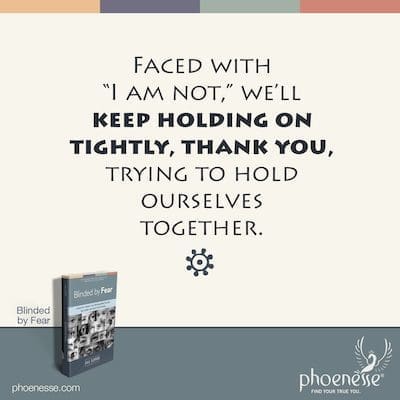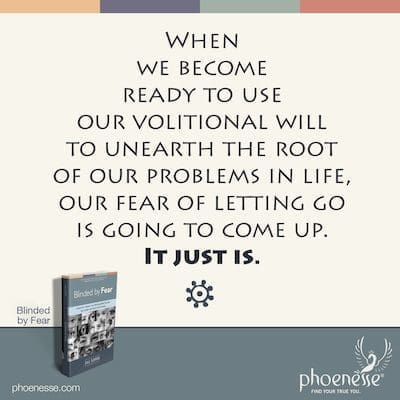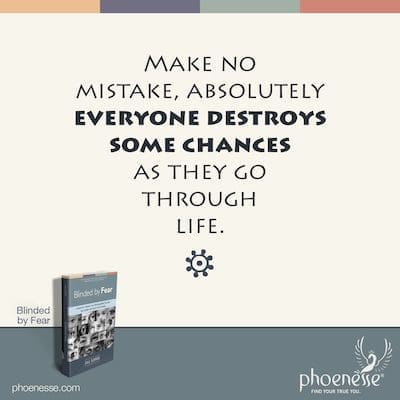Underneath our ordinary, neurotic, unconscious wrong thinking lies a difficult conflict embedded in all of humanity: We have a deeply ingrained longing to be happy and, at the same time, we fear happiness. And this fear is directly related to our fear of letting go. By the same token, our longing to be happy must also be a longing to be released from the clutches of our little ego. The two are linked. Let’s now dive into a deeper level of this topic so we can come to a new understanding.
Everything exists in both a right understanding and in distortion. Letting go of the outer ego is no exception. It’s possible then to let go in an unbalanced, distorted manner, which is unhealthy. Now first, what are we talking about when we say “let go of the ego?” These are the faculties we have direct access to: our volitional thinking and our will that we have the power to direct.

Here’s a simple example of the difference between direct will and indirect will on the level of the physical body. With our direct will, we can decide to move our hand, directing how it will move and what we’re going to pick up with it. But for our heartbeat or circulation, we have no direct control. We can however regulate our heartbeat and circulation by controlling the movement of our body.
Our will also works the same way on the mental and emotional levels. We do have the ability to change unpleasant feelings, but it’s futile to try to do this directly or quickly. What’s more, when we direct our will in the wrong way, we can throw our psyche into a state of disarray.
When we overexert our will, then, by trying to exert it in areas it can’t directly control, we waste energy and debilitate ourselves. It’s the equivalent of throwing all our might into changing our heartrate using our sheer outer will. If this works at all, it only worsens our condition. In truth, we have lots of way to improve our circulation, but forcing—by using our outer will—isn’t one of them.
We human beings do this a lot: We use the wrong approach. We force our will where it doesn’t belong and then neglect using it where it could be doing a lot of good in our personal development. When we don’t use enough will in the right way, our ego becomes weak. When we use too much, our ego becomes so exhausted it will try to escape from itself. Letting go like this, though—from weak motives instead of from a place of inner strength—is an escape that can become quite dangerous to the self.
The healthy ego
If we want to properly let go, we need to start with a healthy, balanced ego, not one filled with false ideas, false fears and destructive attitudes. This is the way to give up our over-tight direct control. Then letting go will not only be possible, but also desirable. All great human experiences arise from this releasing of our too-tight control to some degree, and deep down we all know this.
All creativity is a direct result of an inner wisdom and intelligence that far surpasses what’s available to the ego-mind. So we want to use our conscious ego-intelligence to deliberately activate the greater wisdom within, which appears to have a mind of its own. And in a way, it does. At first, we’re often completely unaware that such a powerful inner intelligence even exists. Then we start to experience it occasionally as this entity that’s not even connected with our conscious selves. Finally, we will integrate these two parts of ourselves.
In order to accomplish this integration, we’ll need to learn how to use our conscious ego for the purpose of waking up our inner self. To do this, we must also learn the fine balance between when to apply the gas and use our outer ego, and when to apply the brake and allow our ego to step aside.
All acts of creation, whether in the sciences or the arts, arise from the inner, non-volitional self, never from the outer ego alone. All great inventions, all lasting values, and all deep spiritual experiences come from the integrated inner self.

Misidentification
Strange as it sounds, humans fear having a great spiritual experience the same way we fear death, which we assume to be horrible. We’ve also exaggerated our fear of death so much we’ve turned it into a seemingly rational fear. Further, we fear the great act of love and the letting go of the little self during the ecstasy of union. In the end, we’re afraid to muster the courage needed to let our inner selves manifest, bringing forth its wisdom and truth.
We are under the misconception that we can only maintain life when we hold it tightly together. That’s why we’re afraid to let go. In this sense, what does “life” mean? It means we don’t want to lose our identity. We don’t want to stop being an individual with a unique existence, a distinct life. Unfortunately, what we’re usually thinking of as our identity is our outer ego’s ability to direct our thinking and our will.
This misidentification causes us to fear losing ourselves. For who would we be without our volitional thoughts and actions? If we let go, we’ll lose our ego and this means death, we think, because we’d feel nonexistent. Faced with “I am not,” we’ll keep holding on tightly, thank you, trying to hold ourselves together.
As humanity has evolved spiritually, we have arrived at this temporary state of holding on too tightly to our egos. Now it’s time to learn to reestablish balance. In our more recent evolution, we’ve concentrated overly much on using our ego faculties alone, such that we can’t see past the seemingly solid wall of matter in front of us. As the ego sees it, this wall separates us from life. This is why we associate our physical separateness with our individuality.
Yes, it’s true that having a weak, ineffective ego diminishes our sense of ourselves as a person. Ironically, that’s the reason we need to strengthen our egos: for the sole purpose of relaxing them again. Then we can integrate our ego selves with what’s indirectly accessible, but which is deeper and wiser.
When we identify exclusively with our outer ego, we must fear letting it go. For doing so threatens our very existence; it seems like annihilation. Our separateness actually results from this threat. It’s the very deepest root of our fear of letting go. But as long as we don’t loosen this grip, we can’t have true happiness.
For all truly beautiful and meaningful experiences emerge from a perfect balance between our volitional outer ego and our non-volitional inner self. Valid and constructive experiences will manifest spontaneously only as long as there’s no overexertion from the ego. And these are the experiences that make us feel at one with the world.
The fact that we constantly long for this oneness—and regardless of whether we’re aware of this longing, it’s there—is totally understandable. For that’s where we’re all heading. It’s our natural state. Evolution is pushing all of us in the direction of unity. This is where we have to go. But we can’t get there if we’re clinging to our ego, refusing to drop into connection and integration with our deeper selves.
When we unwittingly block ourselves from our destiny by trying to escape life and letting our fears and misconceptions lead to self-alienation, we create a conflict deep in our psyche. Then our greatest longing—to reach the fulfillment of oneness—becomes our deepest fear. This dichotomy between desire and fear will be strongest in the areas of our lives where our strict control won’t allow our ego to step aside and let our inner self surface.
In the areas where such over-control has gone on for some time, we’ll become exhausted. That’s when we resort to false means for freeing ourselves. We can’t stand how the burden of our too-tight control has overloaded our faculties and cut us off from our inner selves—which are infinitely better equipped to serve us—so we start looking for relief.
In an effort to experience the wonder and richness of the universe, we’ll grab hold of whatever false means—even dangerous ones—will help us flee our over-functioning egos. There are myriad ways we unconsciously try to escape from ourselves. Alcoholism and drug-addiction are more extreme forms of what often arises; dissociating is a less extreme form. Then when these bring unpleasant results, we become all the more convinced of how dangerous it is to let go. So we fall back into the other extreme of holding on too tightly to the ego, which is what caused the imbalance in the first place.
Only a healthy, robust ego can afford to let go of itself. Such a strong ego can give itself up and mesh with the larger self. Letting go, then, is the story of the human ego that has a happy ending.
Self-perpetuating processes
When we consider the story of our life, we may find there are areas that function perfectly well. Perhaps we’ve arrived into this life functioning healthy and free in certain aspects. Or maybe we’ve done enough spiritual healing work in a particular area to have established healthy patterns. However we got there, the positive self-perpetuating principle is working.
All self-perpetuating processes are like magnetic fields, with new energy constantly arising from their nucleus. So every attitude we harbor about an area of our lives—made up of all our impressions and actions—forms a nucleus of energy that creates reactions and interactions. For each of us, a number of basic life experiences combine to form such force fields.
Some of the fundamental ones applying to all of us are: our attitude toward work, our relationships in general, our values about material things, our physical health, and our outer appearance and activities. A magnetic field is also created by our attitude toward nature, leisure, art and pleasure, and by our take on spiritual reality, self-development, and assimilating new information. These all form separate energy fields that attract.
In every human life, some of the self-perpetuating fields we generate will be positive and some will be negative. Where they’re positive, things go smoothly. We don’t struggle and yet desirable results come our way as if by themselves, without creating problems for us. There is effortlessness and harmony. We take the right action at the right time, both inwardly and outwardly. We say and do what’s appropriate at just the right moment. Nothing stands in our way. Things fall into place.
We are guided by our own inspiration and resourcefulness, which function well. In such areas, we’re apt to take smooth functioning for granted, unaware of the mechanics of what’s happening behind the scenes. But if we start to pay attention, we’ll see that our ego is doing its part, but it’s not exclusively in charge. For it would be out of its league trying to get so many factors to function so well together. That’s a typical description of a positively working magnetic field.
What’s our life experience like when there’s a negative magnetic field in operation? It’s not just that there will be failure and difficulty, but there will also be pressure, wrong timing and frustration. Things won’t work out. When we look more closely, we’ll see that the ego is pushing, assuming that’s what is needed to overcome the obstruction. What follows instead is pain and disappointment.
Sorry to report, it doesn’t work to directly control the result itself. We waste our energy when we try, thinking we can change a negative field into a positive one. For that’s not what we can control. We can, however, directly control all the things that make up a negative field.
That is to say, we can examine ourselves. We can uncover our hidden thoughts and feelings and attitudes. Once we’re aware of them, we can decide if we want to continue in the same vein, or change. We’re in charge. Would we rather stay stuck in a climate of helplessness and hopelessness, or are we willing to clean up our inner climate and subsequently create a new positive attitude? It’s our call.

Unearthing magnetic fields
No one is more fatalistic than a person who is blinded by the material world, ignoring spiritual realities. Such people are often superstitious, believing in “good luck” and “bad luck” because they can’t see what’s going on beneath the surface of what’s seen with their eyes. In our shortsightedness, we call the results of a positive energy field good luck, and the negative, bad luck. As a result, we overlook the fact that we have an influence on those unlucky areas.
But unlucky areas aren’t going to change without honest self-confrontation. And this must start by realizing that it could be possible for change to happen. But we can’t just press for change. We have to use our will to discover the nuts and bolts of our negative self-perpetuating machinery that we ourselves have created. We have to make the effort to reorient ourselves. Then we can set new positive fields into motion. That’s the way to turn things around.
How do we find out if we have any destructive material inside generating negative force fields? It’s quite simple: How do we feel about letting go of our ego control? If this brings up fear, we’ve got work to do. But hang on a second. If our destructiveness is being generated by a negative magnetic field that’s egging it on, won’t letting go of outer control amount to handing the reins to this out-of-control force? From this point of view, our refusal to let go is understandable. It might even seem like healthy self-protection.
In fact, when we become ready to use our volitional will to unearth the root of our problems in life, our fear of letting go is going to come up. It just is. So how do we keep this from overwhelming us? We need to get specific: “In what specific areas of my life are negative force fields operating?” We need to see them clearly, perhaps even writing them down. Be precise. But let’s also be sure to see the positive fields. Put them side by side. This is important. None of us have only negative magnetic fields.
Seeing how both modes are operating will help us relax. For the negative parts are never all of us. That’s what we fear to be true, but it’s not. And those negative magnetic fields will already begin to weaken just by being looked at and understood. Positive self-perpetuation then is just around the corner.
When positive fields are working—whether we’re conscious of them or not—there will be trust. The bigger our ratio of positive to negative fields in our psyche, the greater we’ll trust in the natural flow of life. The more we trust, the more letting go won’t be a problem. This is the only way to establish trust in life, trust in ourselves, and trust in God.
To tell someone to trust in a faraway God is a meaningless command that too often turns into an impossible demand. Rather, by correcting our negative fields that endlessly produce painful patterns, we’ll discover that life—and therefore God—are trustworthy. By understanding how and why our negative fields work, and why they exist, it will become self-evident they don’t need to exist. Then our trust will be justified, even before all our inner distortions have been transformed.
So underneath every negative magnetic field is something that can be trusted and activated. The more we contact this vast but now-hidden power, the easier it will be to switch over all our circuits, in all areas of our lives, converting destructive channels into constructive ones.
We must strengthen the muscles of our egos so they become strong and healthy. That’s the only way to integrate ourselves with the utterly reliable part of ourselves that operates independently. We’re not some passive bystander, waiting for things to happen to us. No, they need to happen through us. We have a role to play. Leaving ourselves out of this process is not any better than taking too much control of the reins. Just as we don’t want to overburden our egos, we don’t want to cast them aside.
Friends, we won’t reach our destination—which is to activate the powerful inner being at the core of each one of us—by charging our egos with tasks they’re not equipped to execute, or by escaping from ourselves and cutting off our possibility for inner connection. Indeed, it’s only by activating our inner being that we can live in harmony with our egos. Then trust, relaxation and a wider world will come into being.
The self-discovery process outlined in the Pathwork teachings provides a map for doing this work of integration. It is a process of recognition, which may sound easy but is often quite hard to do. For we are wired to glibly rationalize away our impulses and drives, without pausing to understand their real nature. To recognize ourselves deeply is a long road that requires courage and a willingness to be honest. Without these things, we can’t get there from here.
When we first attempt to observe ourselves closely, we might feel anxious; or we may find ourselves feeling impatient or irritated. Instead of explaining these feelings away, it helps to jot down some key words. Otherwise they will easily slip away. What are the moments exactly that make us feel uneasy? When has this happened before? What fleeting thought just went past when this anxiety came up? Try to pinpoint it. Hold onto it. After a period of days or weeks, a list of key words will form. From this, a clear pattern or common denominator will surface. This may be a comparatively easy way to sense a larger negative energy field that hasn’t been evident before.
Our evasions cause us so much needless suffering. We feel fear arise and we run for an escape. By facing ourselves, though, relief and growth are possible. Perhaps we can see that what we fear is the truth. Then we can say to ourselves: “I don’t need to fear the truth. This is not a rational fear. It’s not founded in reality. It’s illogical. I will not give in to this fear. Right now, I am making a decision to face whatever it is. I wish to know the truth and I ask for all the help available to do so.”

Fear in relationships
Let’s say we’re just starting into a new relationship and things look promising. How do we move forward knowing our still-existing problems may impede the relationship and ultimately ruin it? In truth, we don’t. But think how much more likely it is that this could happen over and over, with us remaining blind to what’s really going on, until we become so bitter we withdraw from life altogether.
Think how much more painful it is to blame false reasons, and how much more constructive life could be when we learn from everything we experience. For make no mistake, absolutely everyone destroys some chances as they go through life. After all, every single incarnated soul has some unresolved problems and blocks.
Also know this: We can’t be drawn to anyone who doesn’t have equal, complementary problems to ours. No more and no less. So both parties in any relationship are equally responsible when things don’t work out. If we’re under the wrong impression that others can’t blunder, and if we feel guilty that we’re not “like others,” we’ll feel overly anxious and compulsive.
But when we catch on that perfection doesn’t exist here, and that everyone is just doing their best, wherever they are on their journey, then we can relax. What’s important is that we accept ourselves where we are right now, with all our present limitations and the consequences they create. That’s how to set about eliminating the limitation and getting more and more joy from each encounter.
Eventually, with each new contact, we’ll become less afraid of people, of love, and of ourselves. Through our growing openness, we’ll contribute more to others, which in turn will boost our own security. With such an attitude, we won’t be living in illusion or distortion. We will see reality and we will grow from what we see. We can’t expect to have all our blocks disappear in one fell swoop.
Let’s not get caught thinking that on the other side of the fence are all the other human beings, and they have no problems, only fully functional relationships. Let’s not be believing that no one else ever destroys anything, while we sit all alone on this side of the fence. Don’t think that if only we could quickly get rid of all our blocks, we too would be standing over there among the privileged ones.
All people inadvertently destroy chances all the time. This is part of the human condition. But making mistakes is not the end of the world. If we learn nothing other than this, we will already stop being so frightened.
Every relationship we enter into is a mutual proposition. If it’s not a good relationship, that’s on all parties involved. Relationships are never a one-side affair. When we know this, we can take our power back. It’s the immature, egocentric child in us that sees things as one-sided and only expects to receive. In a strange paradox, the weaker and more helpless such an egocentric person is, the more they tend to blame themselves alone when a relationship fails. For when we can only see our own needs and desires, we think we’re the only ones who count. So then we can’t share the brunt of failure when a relationship falls apart. At the same time, such a person can’t access their inner power so they can be giving toward the other person.
On the other hand, when we become more mature, outgrowing our egocentricity, we can experience ourselves as being on the same level as the other person. So then our concern for the other person must grow. We will realize that we also hold the power to make someone else happy or unhappy, which is something we had previously thought only the other person could do. This will make us feel much more secure.
As this shift occurs, it’s likely we’ll fluctuate between blaming ourselves and blaming the other person. Our goal is to not show up as a begging child, so we can know our own strength and our potential to give. Our intelligence, observation and intuition will all be important, as will our ability to balance both our active and passive contributions to the relationship.
How freeing it will be to realize that both people are involved. For if the other person had no problems, their healthy state would overcome all the difficulties in the relationship. That’s the power of true spiritual health. Never forget that all negative fields can be reversed, if we truly desire this and are ready to do the work.
“Be blessed, my dearest ones. Be in peace. And be in God.”
–The Pathwork Guide
Ways to learn more
Next Chapter
Return to Blinded by Fear Contents



